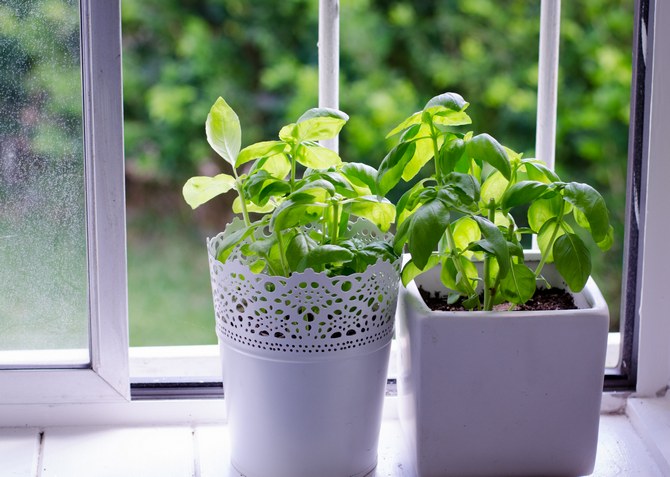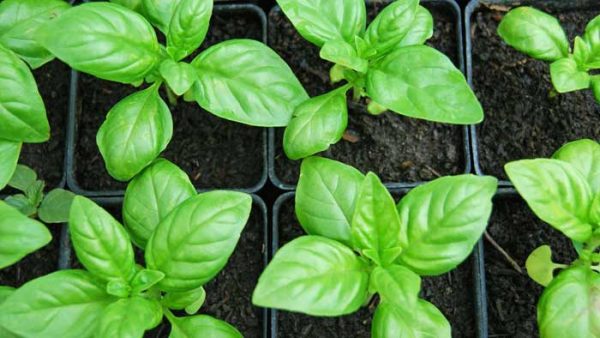How to grow basil at home: tips for beginners
Content
Varieties for growing at home
Growing basil at home involves the use of small-leaved, low-growing varieties: it is better if the plant does not grow more than half a meter up.
The following varieties have proven themselves well in apartment cultivation:
- dwarf forms a small compact bush, no more than 20 cm high. It has a high decorative effect, therefore it is often grown by housewives not only to obtain spicy aromatic greens, but also simply for beauty. Especially if you plant plants of different colors - green and purple;
- marquis is another popular variety with a medium early ripening period and small growth - only up to 25 cm. This type of spice has a pronounced clove-pepper aroma;
- troll - bushes reach 40 cm in height, leaves are small, purple-green.
Video "Benefit"
From the video you will learn about the benefits of the spicy plant basil.
What conditions are required for growing
Deep, capacious containers are best suited for basil: the culture has a fairly powerful, well-developed root system. It is imperative to place a drainage layer under the soil, consisting of expanded clay or fine gravel - the plant needs abundant watering, but so that good soil permeability is maintained, and the water does not stagnate.
The soil should contain humus, peat and clay. Basil is a light-loving crop, so a sunny window sill is best suited for growing it; even in winter, a central heating battery will provide the seedlings with sufficient heat.
If natural lighting is not enough (when the window sill faces the north side), it makes sense to arrange additional lighting. It is very important to ensure that the sprouts are effectively protected from drafts.
For the germination of basil to be successful, it is important to provide it with a temperature of at least +25 degrees. April is considered the best time for sowing seeds, then for the period of active development of plants they will receive a sufficient amount of light and heat. But if you are a fairly experienced indoor grower, you can sow basil any time of the year and place the boxes on the kitchen windowsill: a battery and additional lighting can easily replace the sun's rays.
Basil cuttings
There are two ways to grow a spice: germinate from seeds or root cuttings. When propagating by cuttings, the upper or middle part of the adult shoot is used. The selected material is placed in a container with water, where the seedlings should give roots. This usually happens within seven days, and after another week they can be planted in the ground. Or you can try to root the cuttings directly in the ground, for this you will have to organize a small greenhouse, covering the cutting with a jar or a cut plastic bottle.
Basil takes root quickly and without problems, and very soon the plant will reach a size that allows it to be harvested for the first time. However, cuttings that have just rooted are very capricious and whimsical, while the sown plants are more viable and hardy. That is why sowing is considered more practical options.
Sowing and preparation for it
Presowing treatment will be required for both soil and seeds. If you decide to use the soil collected by yourself, be sure to decontaminate it by heating the soil in the oven for an hour. Those mixtures that are sold in specialized stores do not need additional processing.
On the eve of sowing, the seeds should be soaked for 24 hours in a special growth stimulator or just between two layers of damp cloth.
It is necessary to make shallow grooves in the soil, not more than 1 cm, observing a distance between rows of about 10 cm. At the same time, when sowing seeds, observe a distance between the grains in a row of at least 7 cm. The crops are sprinkled with earth and moistened. After that, you need to cover the container with glass or transparent film, and place in a warm place. It usually takes about a week for seedlings to emerge. Young seedlings need to provide a sufficient level of lighting: daylight hours for them should last at least 16 hours.
As soon as the sprouts grow up to 5 cm, they can be planted in separate containers or transferred to a deeper box.
Care
Until young seedlings reach 5 cm, it is enough only to water them, without resorting to loosening. Once the plants are sufficiently rooted, the soil around them should be loosened every few days. Basil is watered at about the same frequency, when the earthen lump dries up a little. Do not allow waterlogging of the soil, the roots can be attacked by a fungus or other infection. Watering is best done in the morning using water at room temperature. For the first time, you can feed the plants at the stage of appearance of two or three leaves, and then about once a month.
To stimulate the intensive development of green mass and lateral shoots, you can pinch the top, but not before the bush forms 5-6 true leaves. When the plant forms an ovary, it must be removed (unless, of course, you plan to grow the spice for seeds). This way you can extend the growth period of the bush, and the leaves themselves will be more fragrant.
Harvesting
Basil develops rather slowly under indoor conditions. You should not pick off the leaves until the plant grows to at least 10 cm. And even after that, it is better to start collecting by breaking off the tops or excessively elongated side shoots so that the plant bush better. If necessary, you can cut off almost the entire bush, leaving only 4 lower leaves, such a plant will again give side shoots formed from the axils of the remaining leaves.
Possible problems
If you are concerned about how to grow basil at home, you may be faced with the problem of gray mold, which appears as a result of over-watering. It is better to remove the affected plant, and sprinkle the ground with ash and loosen it up.
Video "Growing at Home"
From the video you will learn how to grow basil at home.



